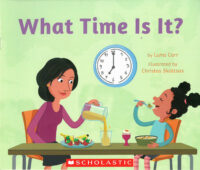Easy Ways to Have Fun Teaching Time Skills
These activities, games, and books will help your students master reading and measuring time.
Trying to teach and reinforce analog clock skills in a digital world can be a challenge in the classroom. Terms like “quarter to” or “half past the hour” make sense on a round analog clock but carry much less meaning in the context of the rectangular, digital clocks primarily used now. Yet students are expected to understand the language and readily move between digital and analog concepts.
When third grade teacher Genia Connell discovered that many of her students were struggling with time concepts, she put together some fun activities that her students could do during math centers and indoor recess. After a few weeks of incorporating the activities into her curriculum, she saw improvement in her students’ ability to convert digital times to analog clocks and vice versa. Try out some (or all!) of her activity ideas below.
It’s LEGO® Time!
LEGO® blocks can be great learning tools in the classroom, and the larger DUPLO® blocks are perfect for practicing minutes before and after the hour. Grab DUPLO® blocks and create sets of matching times written in different formats (for instance, 3:45; 45 minutes after 3; a quarter to 4) on different colored blocks. Throw in a few pieces that are close but don’t match any sets. Students can then work together to match the digital times with the correct wording and record the times on analog clock faces using this printable.
Tip: Permanent marker comes off the plastic easily with a little oil soap, allowing you to create new time sets or incorporate the blocks into other learning activities.
Eggsactly the Right Time
Plastic eggs are perfect for this alternative time matching challenge. On the larger halves of the plastic eggs, draw either analog or digital clock faces showing different times, and on the smaller halves, describe the time in words. Mix up the tops and bottoms of all the eggs so it doesn’t become a color-matching game.
This is a great cooperative learning activity where students can help each other come up with matching strategies, such as creating separate piles of tops and bottoms to make the task more manageable. Students should record the times, represented three different ways, on this worksheet.
The Human Clock Game
Whenever her students had to write the numbers or draw the hands on blank analog clocks, Connell noticed that many struggled to place the numbers symmetrically while others confused the hour and minute hands. She came up with a game the class could play together to practice these skills. It’s the perfect activity for a brain break or indoor recess!
To Play:
Print out two sets of numbers 1-12 and add two blank pieces of paper to each set.
Divide your class into two equal groups and go to a large space where there is room to make two human clocks.
Announce a time (eg: 3:45) and then say “GO!”
The students in each group should draw numbers from their set of paper and arrange themselves in a large circle to form the clock positions 1-12. You should mark where the 12 is located on each clock so the students can orient themselves more easily.
The students who drew the blank pieces of paper become the minute and hour hands of the clocks, based on their height (the shorter student becomes the hour hand).
The winner is the group that forms their human clock first with all of the numbers in the right place and the minute and hour hands pointing to the correct time!
I Have . . . Who Has . . . ? Activity
This activity works well as a warm-up for students to practice listening, as well as time skills. Print out this premade set of cards or make your own set using the blank cards in the PDF file. Cut out each card and laminate them for durability. To play, shuffle the 28 cards, pass them out, and select a student to start the game. The student should read their card aloud (e.g., I have half past 10, who has 10 minutes before 2 o’clock?) Then the student who has the card: I have 1:50, who has… steps forward and reads their card. The game continues until all the cards have been read.
Time Bingo
For a small differentiated group activity, try out Connell’s Bingo alternative, Time-o. Depending on the ability level of the students playing, you can change the way you say the time as you call out the numbers. For example, instead of saying 6:30, you can say half past six, and instead of 8:37, you can say, 23 minutes before 9 o’ clock. Download and print this PDF for a premade bingo game that includes 30 cards, call numbers, and a board to track the times that have already been called.
Elapsed Time Word Problems Starring… YOU!
Calculating elapsed time is often the most challenging part of a measurement unit. To encourage her students to practice elapsed time word problems, Connell created number stories modeled after those in her book, only she substituted familiar names (including students!) and situations to make them more fun.
She found that her students tackled these types of word problems with more excitement and determination than the ordinary problems they had no connection with. Instead of dreading the daily word problem, her students were excited to find out who would "star" in the new day’s challenge. It’s a simple lesson tweak that led to excellent results.
Shop essentials on telling time below! You can find all books and activities at The Teacher Store.
Telling time to the hour is represented with analog and digital clocks during the school day.
Covering the history of measuring time with funny and interesting examples and illustrations, Wells takes readers back in time visiting the ancient Egyptians, who were the first civilization to keep track of time. Fast forwarding through the centuries, the author explains how the moon was used to keep track of months, and how the Julian calendar came to be.
Of all the math skills children learn in primary grades, telling time and calculating money probably have the most relevance in their daily lives.









